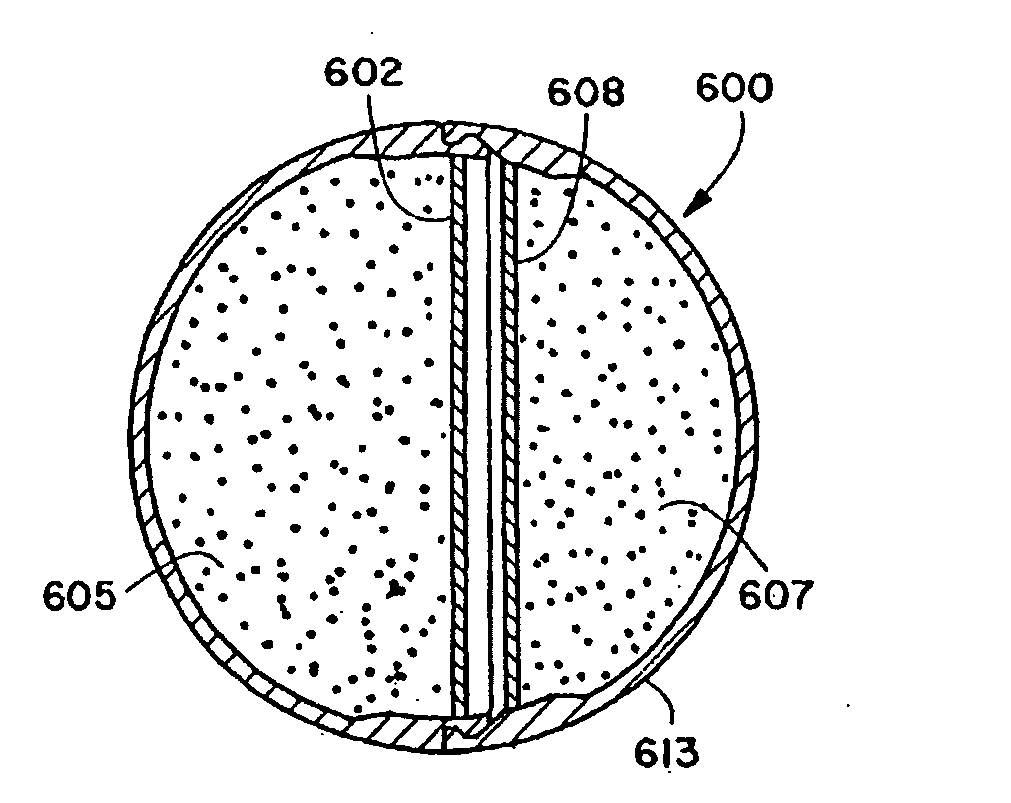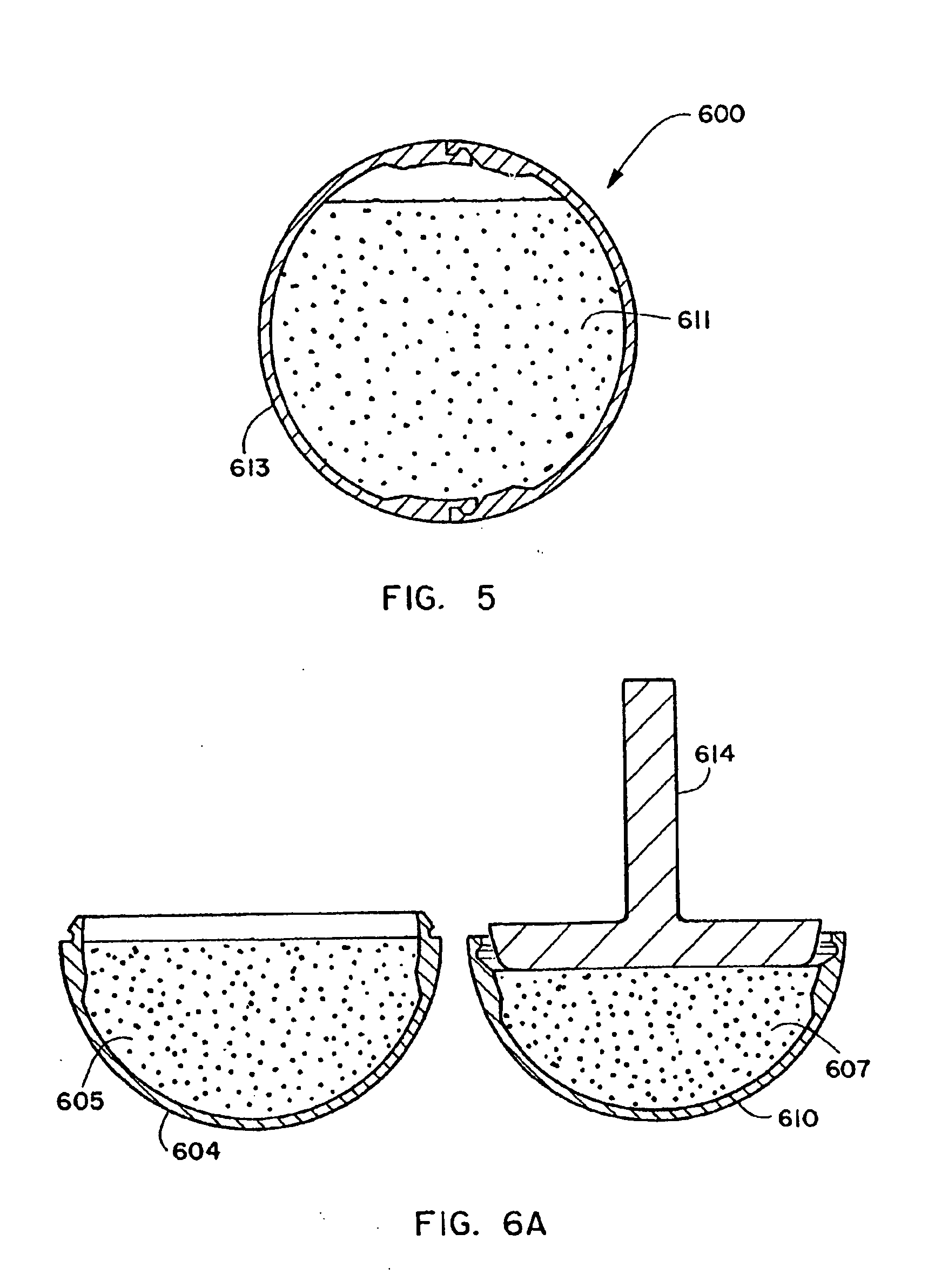Furthermore, excessive use of force claims against law enforcement have increased as the public is becoming more aware of and sensitive to the use of lethal force, typically by law enforcement officials, in situations where lethal force may not be required, such as in situations where suspects are armed with non-lethal objects, such as sticks, rocks, or screwdrivers.
Whereas non-permanently injuring an innocent bystander, while subduing a suspected criminal, is acceptable, killing the bystander is not.
Disadvantageously, the projectiles described by Fogelgren, particularly those projectiles described that would be suitable for delivering loads such as tear gas or dye, are complicated and expensive to manufacture.
In addition, such embodiment requires complicated and tedious methods to manufacture components such as a microminiature ball valve (through which the portion of the pressurized gas enters the rear chamber upon firing), wax sealer within each of the plurality of apertures and a holding pin that must fall away from the projectile in flight.
The embodiment employing the breakable glass vial is also complicated to manufacture, because it also employs a holding pin that must fall away during the flight of the projectile and employs numerous structures that must be precisely fitted together to allow them to separate during firing and in flight.
This can be particularly problematic, for example, when the Fogelgren device is being used by a police officer in pursuit of a fleeing criminal (or when used by a police officer threatened by a suspected criminal).
Additionally, the Kotsiopoulos, et al. disclosure includes a only passing reference to the use of such a paint ball for delivering dyes, smoke or tear gas to a target; however, provides no mechanism for dispersing an inhibiting load upon explosion of the projectile, which is important for a non-lethal inhibiting projectile to be effective.
Thus, even if one skilled in the art were to act upon the passing reference to using tear gas in the Kotsiopoulos, et al. patent, the present inventors believe that such a device would be generally ineffective because the tear gas would not be dispersed to the target's face, where it needs to be to be effective.
Furthermore, as Kotsiopoulos, et al. is an unpressurized projectile, the amount of tear gas delivered would necessarily be limited to an unpressurized volume having dimensions of a paint ball.
This limited amount of dispersed paint in the context in which the Kotsiopoulos, et al., device is used (as a paint ball) would be ineffective as a non-lethal device unless the target was hit near the eyes in order to blind a target.
However, such a direct hit in the eyes or face could prove dangerous to the target.
Because firing even a non-lethal or less-than-lethal projectile at or within a few inches of a target's face is extremely dangerous, potentially causing permanent injury or death, which is, of course, contrary to the objective of non-lethal projectiles, devices such as those suggested by the teachings of Kotsiopoulos, et al., would be considered undesirable by those of skill in the art to achieve a non-lethal inhibition of a target.
While each of the devices described by these patents attempts to provide a projectile that may be used to stop or slow a living target without causing lethal injury, all of the devices have proven to be less than ideal and some have even proven to be fatal when fired at close range to the target.
They are complicated and expensive to manufacture, and they are variously difficult to use and unreliably effective.
As a result of these problems and others, there is no widely commercially accepted non-lethal projectile in use by law enforcement or military personnel today that delivers an inhibiting substance to a target.
A significant disadvantage to the prior art devices is that none takes into consideration the need to deliver an inhibiting (or active) substance under fairly precise dispersal conditions to insure effectiveness thereof.
Unfortunately, prior art projectiles, not only rarely contemplate these problems, but also frequently fail to provide for dispersal of the inhibiting substance to a target's face after impacting the target at a remote area.
Specifically, for example, while powdered inhibiting substances, in the view of the inventors, offer distinct advantages over the vast majority of prior art devices that deliver inhibiting substances to a target, no commercially viable device known to the inventors has ever been produced that addresses the problem of both accurately delivering the projectile to the target at a location remote from the target's face, and dispersing a powdered inhibiting substance in a cloud-like, radial manner so as to assure that the powdered inhibiting substance reaches the target's face.
Unfortunately, using devices heretofore known to the inventors, targets are often able to escape and / or minimize their exposure to the delivered substance.
A further disadvantage to most non-lethal weapons heretofore known is that they either operate at close ranges, for example, pepper spray canisters, or operate at long ranges, for example, rubber bullet devices, but do not operate at both close and long ranges.
In particular, the close range weapons are generally not deployed with sufficient force to travel further than a few meters, and the longer range weapons generally are not “muzzle safe” in that they cannot be safely deployed at very short distances because of the chemical / explosive nature of the launching mechanism.
For example, cost is a significant factor recognized universally by governmental agencies, but perhaps even more importantly is a tactical disadvantage imposed by the use of both short range and long range non-lethal or less-than-lethal technologies.
This requires not only spending time to assess a situation in order to determine whether non-lethal or lethal technology should be employed, but also requires expenditure of more time determining which non-lethal technology is appropriate, that is whether the situation calls for short-range technology or long-range technology.
As a result, non-lethal and less-than-lethal projectiles are rarely used by law enforcement and military personnel, and, when used, are generally used only in situations where sufficient time exists for the user to make the chain of decisions necessary to first select non-lethal technology and second, to select what range of non-lethal technology is appropriate.
Furthermore, most non-lethal technologies are “single shot” devices that require may time and effort to reload the device, reducing the effectiveness of the non-lethal device and the reducing the users decision to employ the non-lethal device over traditional lethal devices.
Because two types of non-lethal technology must, using heretofore known technology, be available, many, if not most, law enforcement and military agencies cannot afford to fully equip their personnel.
This cost constraint is further exacerbated because heretofore available non-lethal technologies, at least the ones that are effective, and thus actually useable, are complicated and highly specialized and most non-lethal devices do not offer a low-cost inert training version.
Thus, training is costly and therefore, use is infrequent.
As a result, even if currently available technologies could be used at both short and long ranges (thus presumably providing tactical and cost advantages), the actual costs of currently available devices is still prohibitive and therefore dictates only limited deployment.
Furthermore, there are currently, no effective projectile systems available on the market for delivering powdered substances to a living target.
One reason for this unavailability is that such heretofore contemplated projectile systems are difficult to manufacture or are ineffective.
While dispensing a powdered substance into a cup is straightforward, dispensing the substance into two parts of an apparatus that must subsequently be sealingly joined together, without loss of any of the powdered substance, is not so straightforward.
Such an approach, however, cannot be used to fill the Kotsiopoulos, et al. device with a powder, as it is known that powder generally cannot be conducted through a capillary as can a liquid or gas.
This manufacturing difficulty combined with the aforementioned difficulties in insuring adequate dispersal of the substance, especially powdered substances, has prevented manufacturers of non-lethal projectile systems from entering the market with powder-filled devices.
Today, to the knowledge of the present inventors, there is no heretofore commercially viable, non-lethal or less-than-lethal projectile for delivering a powdered inhibiting substance to a target.
While powdered inhibiting substances are known, there is presently no delivery mechanism available for accurately delivering and dispersing such an inhibiting substance in a non-lethal, short or long range manner.
Finally, an additional problem faced, in particular with law enforcement personnel, is that an officer essentially becomes “bogged down” with too many physical devices.
Due to size considerations of the various devices and the available real estate, it is very difficult to fit all of these types of devices on the officer's person, on a belt, for example.
The devices simply take up too much physical space.
Such an assortment of devices may actually bog down the officer such that the officer will not be able to move as quickly if pursuing a suspect, or the officer will be delayed in selecting the appropriate device to use.
Such a device, in the form of a clipboard would not be practical for law enforcement officers other than in the standard traffic stop to issue a ticket.
The clipboard would not be useful to an officer conducting a drug raid or pursuing a suspect, since the clipboard itself is bulky and not conducive to fitting on the belt of an officer.
 Login to View More
Login to View More  Login to View More
Login to View More 


